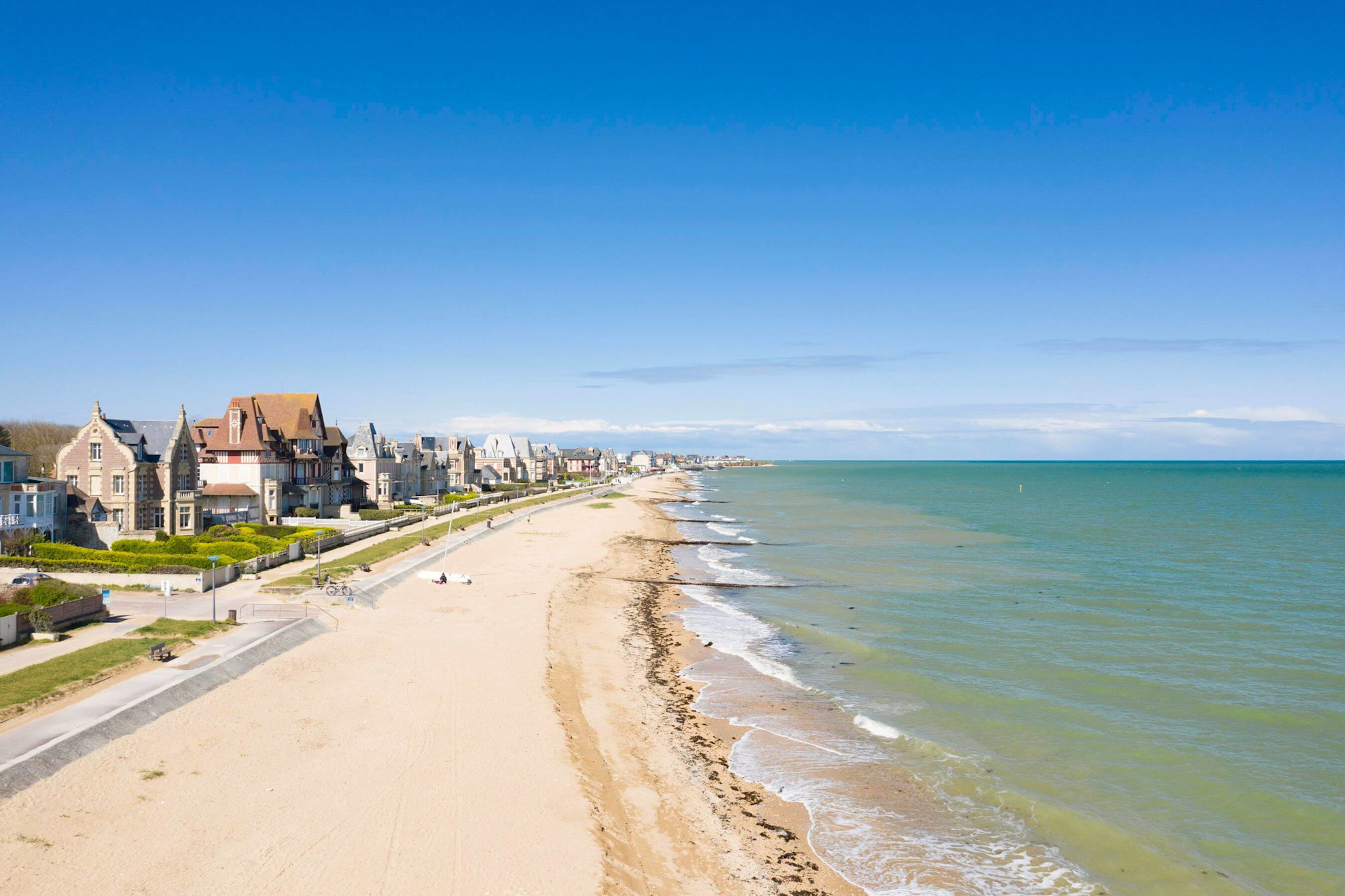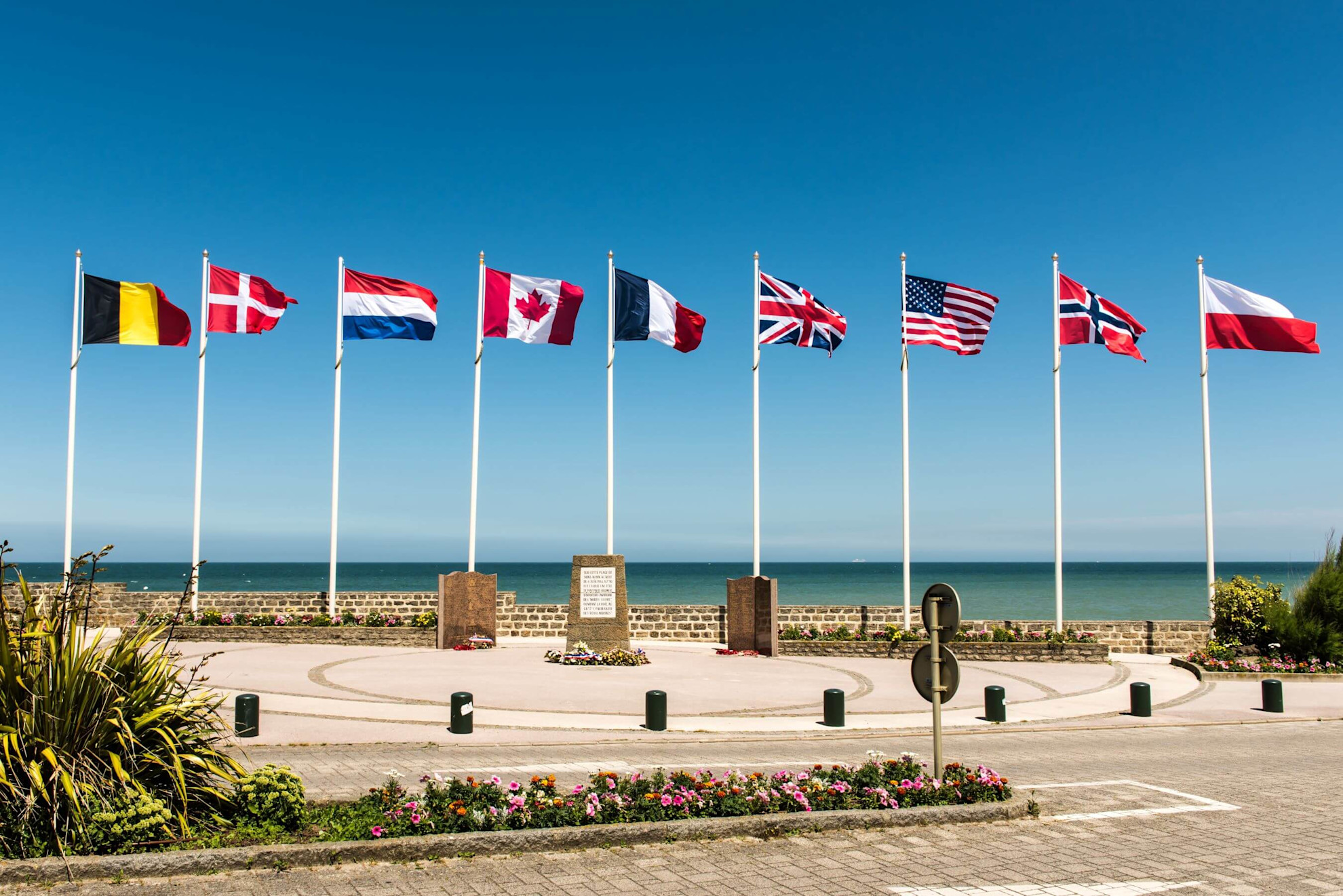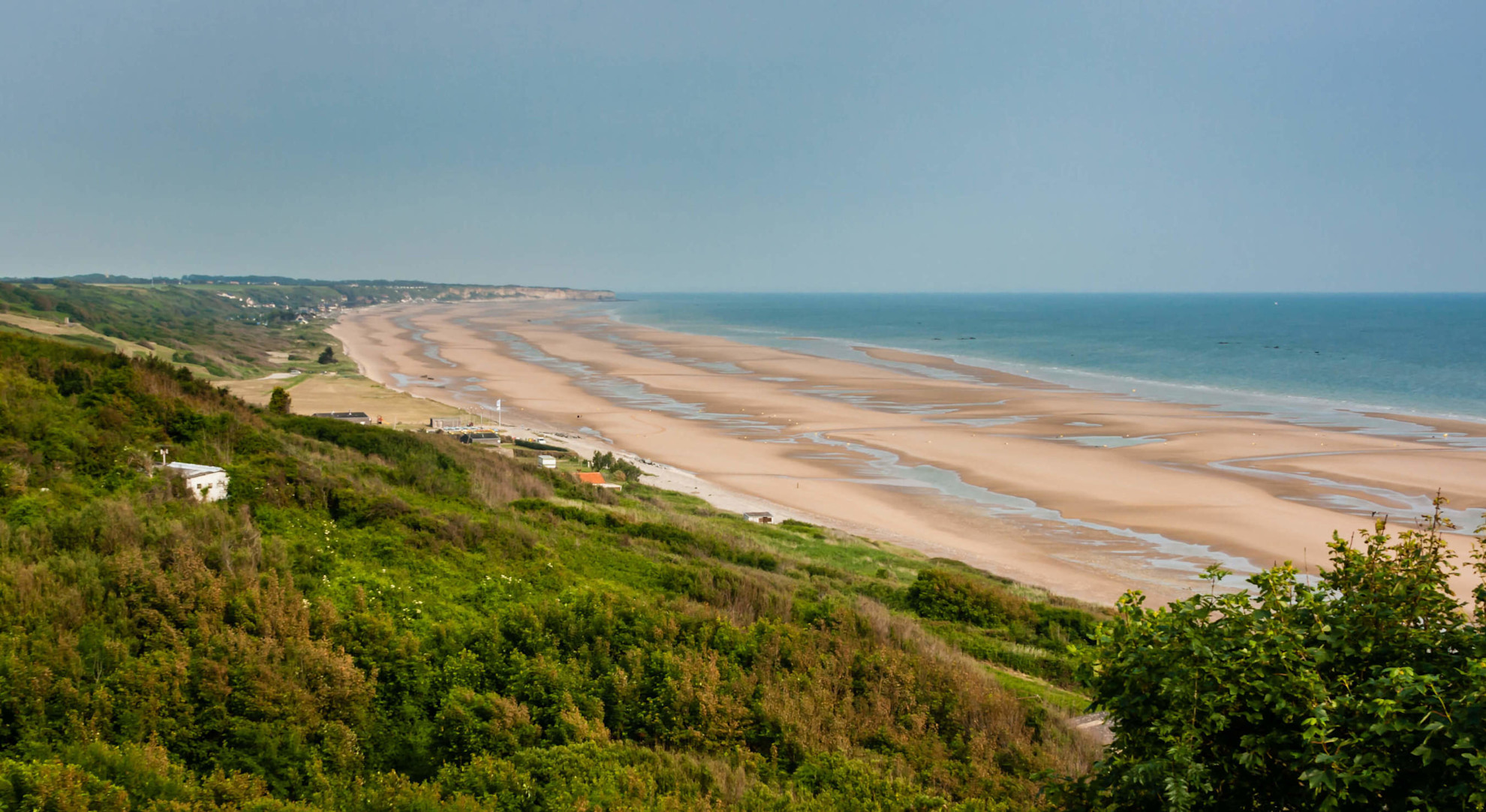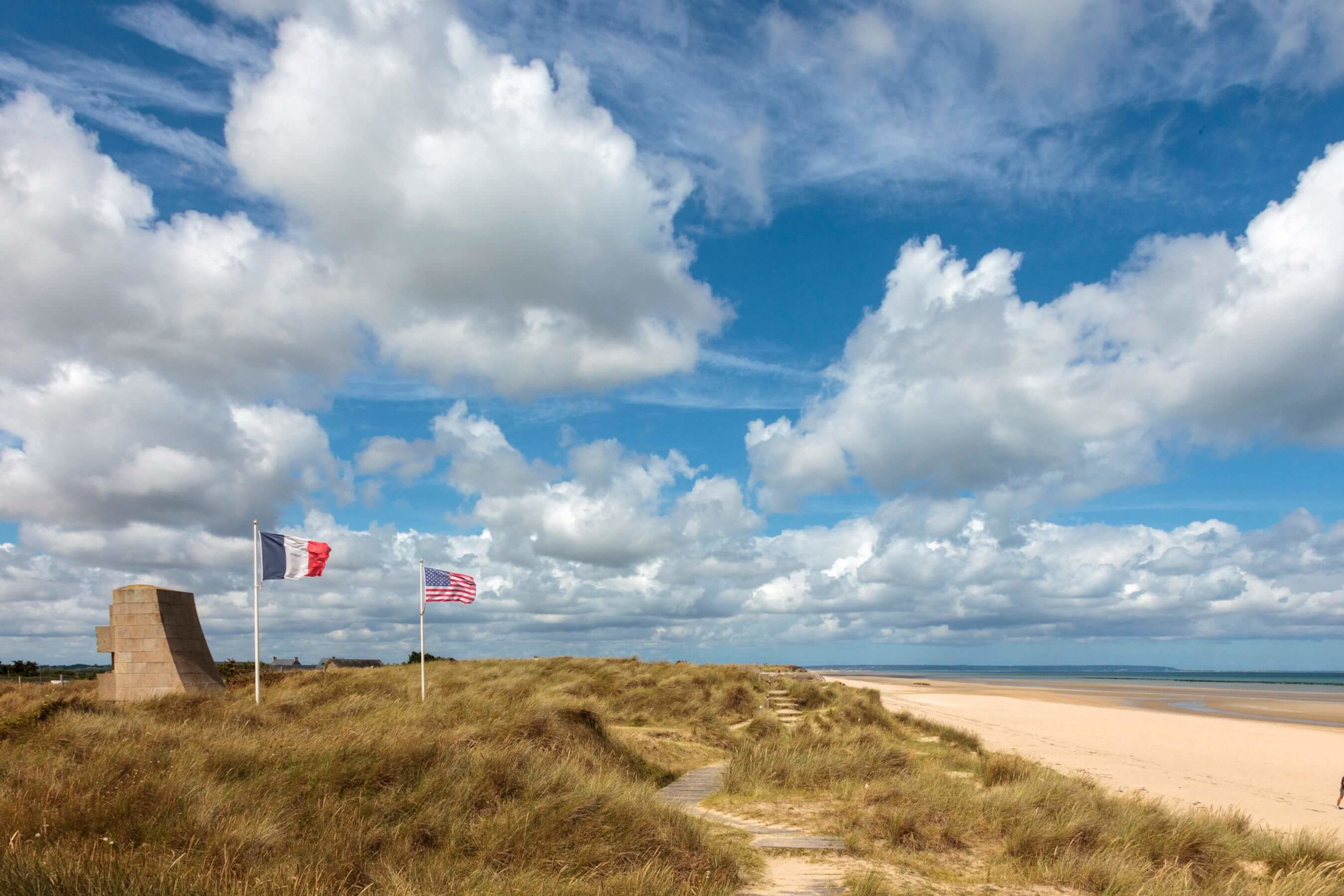DISCOVER D-DAY
THE BEACHES

WW2 D-day beach, Arromanches, Normandy
The D-Day beaches to visit in Normandy
On the morning of 6th June 1944, the Normandy coastline was scattered with Allied landing ships. Armed warships sat further out, engaging in a naval bombardment of German gun positions. Hundreds more ships crossed the English Channel throughout the day, bringing over 132,000 troops from England to Normandy on D-Day alone. A further 23,000 airborne troops were landed nearby the night before to capture and secure key positions, including German gun batteries that could fire on the landing beaches.
Hitler's coastal defences, known as the Atlantic Wall, posed a serious problem for the Allied invasion of France and the beaches were sites of fierce fighting where many men made the ultimate sacrifice. Omaha Beach in the American sector, immortalised in the Steven Spielberg film Saving Private Ryan, is well-known as the bloodiest of all the beaches, with American losses numbering nearly 3,000. Along the coast, the beaches were code-named by names they are still known as today: Utah, Omaha, Gold Juno and Sword. Stretching from the Carentan estuary to Ouistreham, the beaches were the site of the largest seaborne invasion in world history.
What you can visit today
Today, there are many memorials at the beaches and along the Normandy coastline here. German bunkers, gun batteries and other evidence of the intense fighting that took place still litter the landscape. We can now enjoy these beautiful beaches for the peace and enjoyment they offer us today, but the incredible events that took place at these historic sites offer an entirely different aspect.
The landing beaches full of memory
Go for a walk along these historic beaches and immerse yourself in imagining the incredible events that took place here on D-Day. Several companies in Normandy offer detailed tours of the beaches with well-informed guides to make the most of your visit.
Sword Beach
Sword beach à Lion-sur-Mer, Normandy
The left-hand flank of the D-Day landings and one of the five main landing areas along the Normandy coast, Sword Beach was one of the British landing beaches and is close to our ferry port in Caen. Overnight the 6th Airborne Division launched a daring glider-borne assault with the objective of seizing bridges inland from the beaches and silencing the enemy artillery, including the gun battery at Merville. The Caen Canal Bridge, now known as Pegasus Bridge, was taken and held by airborne troops while the landings began in the morning of 6th June 1944.
Led by the 3rd Division, with French and British Commandos, the attack moved quickly and within 45 minutes, the Allies were fighting the Germans inland. The beach defences had included machine guns and mortars amongst the sand dunes. By 13:00 the Commandos had linked up with the airborne troops at the bridges they had taken over the river Orne and its waterways. However, the right flank of the attack was unable to link up with the Canadians landing at Juno Beach and the Germans organised a counterattack. The German Panzers were halted by antitank weapons, air strikes and the Allied tanks that had landed, effectively stopping the counterattack.
Today, Sword Beach is a clean and popular expanse of golden sand with good facilities including toilets and showers. In summer, you can find people playing sports such as football and volleyball on the beach as well as a number of attractions for kids such as a mini-golf course and go-kart track. There are also plenty of places to enjoy an ice cream or a snack, as well as several restaurants nearby. Why not sit on the beach and watch as your ferry comes in? For those looking to discover more about its place in history during WW2, there are still remnants of the area's historical past with memorials dedicated to the different British units and traces of gun turrets. The Grand Bunker Museum, where a garrison of Germans formed a pocket of resistance for 3 days after D-Day, is a short walk away.
Juno Beach
The flags of Allied nations at Juno beach memorial
Around halfway between Gold Beach to the east and Sword Beach, which formed the left-hand flank of the D-Day Landing beaches, is Juno Beach. Here, the Canadian 3rd Division came ashore, later than the other landings due to natural off-shore shoals and reefs. When the first assault landed at 07:55 the tide was rising and the beach obstacles were partially submerged, making it difficult for the engineers to clear the way and leading to problems in landing. Around 30% of the landing ships at Juno were destroyed or damaged by mines on the beach and once the troops began moving inland, the German guns took a terrible toll.
However, in spite of facing heavy and fierce opposition at Courselles-sur-Mer, the Canadian forces broke through to take the towns of Bernières-sur-Mer and, later, Saint-Aubin with armoured units making their way towards the Caen-Bayeux road. By evening, Canadian troops had linked up with British troops from Gold Beach to the west, but there was still a gap between the Canadians and the British forces landing on Sword Beach to the east. This allowed the Germans to orchestrate a counterattack by the 21st Panzer Division.
Bunkers can still be found today along Juno's coastline, in particular the bunker outside of the museum, the Juno Beach Centre. Dedicated to showcasing the Canadian involvement in WW2 at Juno Beach, the museum's courtyard features a memorial sculpture entitled Remembrance and Renewal by Canadian sculptor Colin Gibson. The Maison de Queen's Own Rifles, a house on the beach which was possibly the first house on French soil to be liberated by the Allies, is today a memorial to the Canadian Queen's Own Rifles who liberated it in the first wave of attacks on June 6th 1944. The house appeared in many of the official photographs and newsreels of the landings.
Gold Beach
A tank on the D Day beaches of Arromanches
From a British perspective, a good place to start your tour is the small village of Arromanches, just a few miles away from Bayeux. This is Gold Beach, where the British 50th Infantry Division landed. The defending Germans were set up in houses along the coast that were bombarded with air strikes and naval gunfire but the Longues-sur-Mer gun battery was not far away. The high tide meant that the demolition engineers couldn't clear the beaches and several landing boats carrying tanks in the first wave of landings struck mines. Once landed, the British troops faced an ineffective German infantry defence after the shore bombardments earlier in the morning.
The guns at Longues-sur-Mer were put out of action during a duel with HMS Ajax and the 47 Commando unit passed west of the town and on towards Port-en-Bessin. By the evening, 25,000 troops had landed on the beach and the British had linked up with the Canadians at Juno Beach. However, the objective of linking up with the Americans at Omaha on their other side had not been achieved due to the destruction the American forces suffered there.
Gold Beach is known for the harbour constructed by the Allies when they landed - Mulberry B. 7 miles long when it was created, remains of the armour still exist today and are clearly visible from the beach. The town's D-Day museum, the Musée du d'Ébarquement, features a wealth of photographs, original equipment, and an excellent and informative film show. The Arromanches 360 Cinema is also nearby, showing a high-definition film using archive footage of the D-Day Landings and the battle of Normandy. The beach itself is a beautiful stretch of golden sand that is enjoyed by locals, as well as a spot for contemplation.
Omaha Beach
Omaha beach is approximately 5 miles long
A few miles west of Arromanches is probably the most famous, and certainly the bloodiest, landing beach of all - Omaha. The cliffs here are still riddled with German bunkers, and deeply scarred with shell holes from the bombardment that this most heavily defended beach of all underwent. With German strongpoints commanding the high ground overlooking all approaches, the advance group of US 1st and 29th Divisions, supported by the 5th Rangers and 5th Engineer Special Brigade, faced a terrifying task. At various points along the five-mile-long beach, the only way forward was by scaling the cliffs and taking out the German positions in a series of direct attacks. The fact that there were around 2,000 US casualties within the first few hours of the landing here speaks for itself. Visiting the beach today, it is difficult to imagine what faced the Allied forces when they landed on these picturesque golden sands. The memorial and the Les Braves sculpture by Anilore Banons are dedicated to those that fell here. A striking metal sculpture, Les Braves is in 3 parts rising up out of the sand - The Wings of Hope, Rise of Freedom, and The Wings of Fraternity. Remains of machine gun placements and German bunkers can still be found along the beach. In Colleville-sur-Mer the Normandy American Cemetery and Memorial overlooks the now peaceful Omaha Beach below.
Utah Beach
Commemorative monument of D-Day landing at Utah beach
Forming the right-hand flank of the Allied invasion, the troops landing on Utah Beach encountered far less resistance than Omaha Beach just a few miles east. Paratroopers from the 101st Airborne Division, commanded by General Taylor, were dropped in the night to secure the exits from the beach and capture the bridges around Carentan. The German defences were generally very sparse but included 4 causeways with locks that were designed to flood the beach, which were secured by the paratroopers in the night.
The landings, led by the US 4th Infantry Division, were pushed off course by strong currents, with the ships landing almost 2,000m away from their intended position. It was Brigadier General Theodore Roosevelt, Jr. who coordinated the landing forces to attack, uttering his famous remark, "We'll start the war from here!" By the end of the day, the troops had pushed 4 miles inland and had met up with the paratroopers holding the roads - with losses of less than 300 men.
Several monuments to the American forces who landed here on D-Day can be found along the coast including a statue of Lt Richard Winters, whose exploits during D-Day and the Liberation of France formed the lynchpin of the Band of Brothers HBO television series. There is also a monument to the US Navy featuring the names of all the ships that took part in Operation Overlord. The Utah Beach Museum is housed partially inside a German bunker, code named WN5, which was at the heart of the German coastal defences.


Plan your D-Day trip
Let us take you straight into the heart of Normandy with our popular sailings from Portsmouth and Poole. And, book a ferry-inclusive holiday or break with us to get your travel and accommodation sorted in one go!









